Art room "must have": Tables, not desks.
Can you imagine prepping a station for every child that came into your classroom? Tables are absolutely necessary for keeping me sane. In my art room, I have 5 tables that sit 5-6 students per table. I also have an extra table in the back of the room for overflow or if I have a larger upper grade class or if a students needs to work "alone". For my two schools, grades K-3 average 20 students and grades 4-6 average 25.
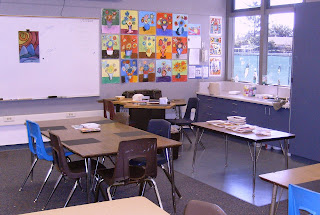 Front part of my classroom.
Front part of my classroom.I have a large white board that I keep free of clutter and two small tables close to the board for my own teaching prep. The sink (very small!) is on the counter under the window.
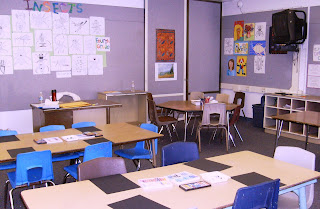 Back part of my classroom.
Back part of my classroom.I have a desk off to the side, a round table in the back for "free choice" drawing (when children are finished of main project) and you can see the edge of my back table where I keep supplies for current projects or clear for extra kids.
Large cupboards flank the perimeter of my art room. I fill them with paint bottles (watercolors, tempera, metallic, glitter paints, etc.), paint brushes, drawing supplies (markers, pencils, etc). I try to sort my tempera paint bottles by color and for most of the year it stays that way, but by the end of the year, it's just a big mess.

 The drawers under my sink are perfect for pastels, painting and prep supplies (water containers, plastic trays for paint, palettes, sponges, etc.) When I'm prepping a lesson, this is where I stand. Everything I need is one drawer pull away.
The drawers under my sink are perfect for pastels, painting and prep supplies (water containers, plastic trays for paint, palettes, sponges, etc.) When I'm prepping a lesson, this is where I stand. Everything I need is one drawer pull away.Prepping a Lesson:
Occasionally, I'll do a lesson where the children are required to mix their own paints (colorwheel projects). If this is the case, I tend to use foam plates for each student. At one school, breakfast is served and I'll go dumpster diving immediately after and pick out all the Styrofoam trays for this exact purpose. Most are dry and clean and only require a quick rinse. Good for the environment and easy on the art budget. Some kids automatically save their trays for me and bring them to the art room.
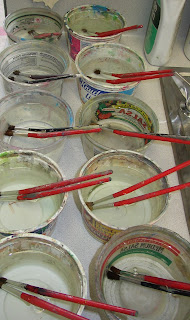 For painting projects, I set out two water containers and the appropriate amount of brushes at each table. this beats giving each child a water container. This might sound mean, but unless we're working with a lot of black paint, I don't encourage the kids to refill their container with fresh water. Most of the time, the water, even dirty water, is completely fine for the project.
For painting projects, I set out two water containers and the appropriate amount of brushes at each table. this beats giving each child a water container. This might sound mean, but unless we're working with a lot of black paint, I don't encourage the kids to refill their container with fresh water. Most of the time, the water, even dirty water, is completely fine for the project.I'm a fan of the hard plastic trays and muffin type palettes shown here on the right. They're easy to clean and stack really well. The trays can be used for everything: markers, pencils, pastels, paint brushes, etc. Whatever tools the kids need.
The tray on the left is permanently filled with essential art items. This makes set-up quick and easy. The only things that come out on a regular basis are the pencils and erasers. if you've been following my art lessons, you know I'm not a fan of pencil drawings, so I only make them available when the lesson really calls for it.


Foil trays are great to use if you don't have access to the plastic ones. I buy them in bulk at Costco and keep reusing them. I fill them with paper, oil pastels, embellishments, anything. I set one or two trays at everyone's table. The picture below shows how I organize a project using tissue paper. I decided to sort the tissue into colors for this particular project. I set the trays on the "back" table.
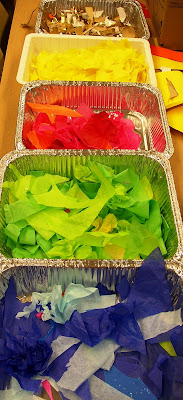 There. That's a start. Next week, I'll show you how I organize teh children's artwork!
There. That's a start. Next week, I'll show you how I organize teh children's artwork!

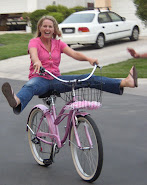







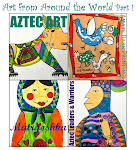
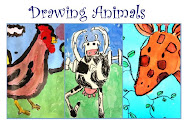
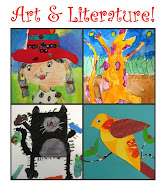


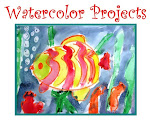





4 comments:
I will be teaching Art starting September to K-6 grade students, what lessons do you suggest I start with? This is my first year teaching Art. I love all of your lesson plans, but I'm having difficulty which ones to start with. Thanks
Evelyn
I like to start with directed line drawings. It gives me a chance to get a feel for how well the class listens and it's a good "warm-up". Also, the set-up and clean-up is easy: just paper and markers.
For upper grades, look at Wild Hair Line drawings (6th grade) and Joan Miro drawings for lower grades.
After that, I like to do a lesson on painting with the primary colors.
Good luck!
Thank you so much for this post. I'm a beginning art teacher and moving back into the art room this year so am figuring out where I want everything and how to arrange the room. This is wonderful information for me!! I appreciate the lesson plans as well, but this post just hit what I'm needing right now!
I can't thank you enough!!Your blog is so helpful and inspiring. I especially appreciate your organization post, this Fall will be my 2nd yr teaching art and I definitely struggled with that last year. I can't wait to get some tips with how you organize the kids artwork. Thanks!
Post a Comment